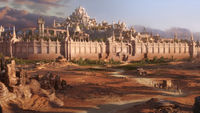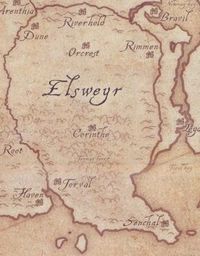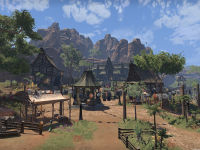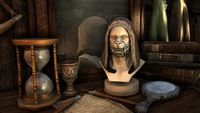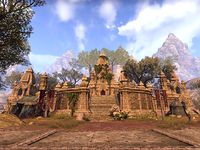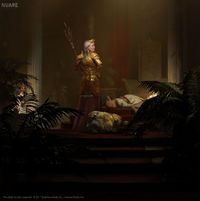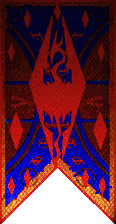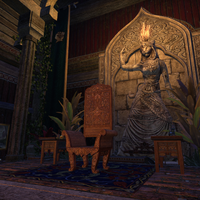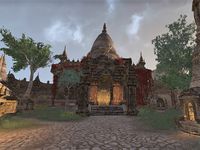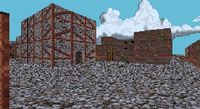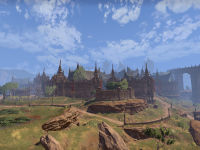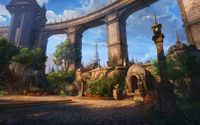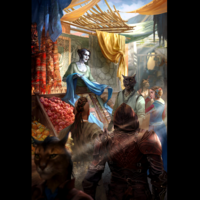Lore:Rimmen
This article is about the city. For the people also called Rimmen, see Rim-Men.
| Rimmen | |
|---|---|
| Type | Settlement |
| Continent | Tamriel |
| Province | Elsweyr |
| Region | Anequina (Rim Territories) |
| Demonym(s) | Rimmenite[1] |
| Appears in | Arena, ESO |
|
Rimmen (Ta'agra: Rim'kha)[2] is one of the eight major cities in Elsweyr,[3] serving as the modern capital of the northern kingdom of Anequina.[4] The city is an oasis of lush greenery and flooded steppes in these northern badlands, supplied by the kingdom's ancient canalways and waterworks. Its year-long warmth and largely clear skies has made Rimmen a popular resort destination for people across Tamriel.[4]
Layout and Geography[edit]
Rimmen is located in northeastern Elsweyr, in a region aptly known as the Rim, located near the border of Cyrodiil. Northern Elsweyr, in general, is known for its scrublands and dry climate, but Rimmen has turned the land around it into lush and vibrant greenery.[4] The hills outside of Rimmen are steepes. The farthest out are ragged, with thorny scrubs[5]:Pt. 2, Ch. 9 but just outside its walls, they are flooded with water and sugarcane paddies.[4] Rimmen appears on the horizon as a golden gleam on a distant hill[5]:Pt. 2, Ch. 9 and many roads all lead to it.[6] Rimmen is neighbored by several settlements such as Meir Lynmount to the far west and Valley Guard to the south.[3]
Rimmen is a walled and heavily-defended city, with soldiers, archers, and siege weapons manned on its gates.[4][5]:Pt. 2, Ch. 9 The city is described as having "elegant bones of ivory-colored stones" and has more dome structures than towers.[5]:Pt. 2, Ch. 9 From the western gate, travelers arrive to Rimmen's central plaza centered around its wayshrine. The wayshrine is surrounded by shallow pools of water, where locals lounge in and around it. The plaza is also in the middle of a broad avenue that runs north-south of the city. Traveling north is the city's artisans district, where many of the local craftworkers are found. Going south is a street moving through southern Rimmen and its wall. Here encampments and caravans are found.[6]
The southern street turns around north into Rimmen's marketplace,[6] described as bustling and colorful. While it is empty in the middle, it is densely surrounded by tents and stalls bound by canals.[5]:Pt. 2, Ch. 9 Here the nomadic Baandari Pedlars make camp and sell their wares. The artisans districts meets here from the west, but northeast of the market lies the city's northern district on its highest level. This area contains several notable landmarks, such as the Tonenaka Shrine and the Hall of the Lunar Champion, monuments of a time long past for both Rimmen and Elsweyr's people. Further east on an elevated stone structure is Rimmen Palace,[6] both a stunning seat of power and defensible fortress.
The city's freshwater comes from the Anequina Aqueducts, which flows all over the kingdom and predates the city by many years.[4][7] Rimmen's main source, however, is a river from the hills behind Rimmen Palace that cascades down through a series of waterfalls and drains in the central plaza. From the calming pools, it flows out into the sugarcane fields.[6] The canals and fountains function through a complex gravity-fed hydraulic system, but the system is so vast that Rimmen's current rulers are not even aware that it drains through underground conduits with a hidden maintenance vault. This part of the city's sewers became its outlaws refuge.[8]
Notable Locales[edit]
|
|
Districts[edit]
Kingdom of Rimmen[edit]
The Kingdom of Rimmen is the political entity centered around the city in northeastern Elsweyr.[11] It was originally one of the sixteen kingdoms of ancient Elsweyr,[12] and although it was later absorbed into Anequina,[4] it has re-surfaced throughout the years as an independent realm.[11] In the years around the fall of the Akaviri Potentate, Rimmen was the seat of kingship, separate from the Kingdom of Anequina.[10]
In the first century of the Fourth Era, while Pellitine was in engulfed in war, Anequina was in chaos and Rimmen, as the seat of the Kingdom of Rimmen was ruled by a Potentate and in relative peace.[5]:Pt. 2, Ch. 9 What became of it after the re-instation of Anequina and Pellitine as Aldmeri Dominion client staes is unknown.[13]
History[edit]
Early History[edit]
Rimmen traces its origins to the ancient sixteen kingdoms of Elsweyr, when it was originally known as Rim'kha.[2] These kingdoms began in the Merethic Era as wayward clans of a particular skill or discipline, and all under the authority of the Moon-Emperor.[14] The original Rim'kha clan of Khajiit established themselves as a fractious people, but also talented traders.[12] These clans were gradually forced into limited geographies to master their disciplines. The Rim'kha Khajiit settled in northeastern Elsweyr and from the onset, the clan was set to be the most prosperous of the kingdoms.[15]
The sixteen kingdoms come from Tamriel's most ancient history, predating the arrival of Man. By the time early human settlers were understanding what plants grew where and under what circumstances, mercantile caravans were already moving through Rim'kha.[16]
The Merethic Era was not completely marked with fortune, however, as through much of that era, the sixteen kingdoms were competing fiefdoms, ruled by a cruel hunter aristocracy that led to famines and droughts for its people. Their only check was the Temples of Two-Moons Dance. It was not until the hunt-lords tried to suppress them and for a long time, the temples' adepts underwent deep meditation did a great change occur. Across northern Elsweyr, peasant uprisings broke out, overthrowing the hunt-lords and bringing a new kind of royalty in the late days of the Merethic Era.[17]
The Moon-Emperors' reigns eventually gave rise to Darloc Brae, known by his epithet, the Golden Beast of Anequina.[14] In 1E 461, Darloc Brae began his campaign over northern Elsweyr, remembered now as the Anequine Conquests. His domain extended from the Larsius River to the Strid,[18] with cities such as Rim'kha, Arenthia in northern Valenwood,[19] and even Leyawiin in southern Cyrodiil under his name.[20] Though this period is described as glorious,[21] memories of Darloc Brae's reign invoked a sense of savagery and brutality.[18][22] The Rimmen Necropolis dates back to Darloc Brae's time and many of his soldiers are buried there.[23]
Rimmen in the late First Era and Second Era[edit]
Rim'kha remained active for many years but like the rest of the sixteen kingdoms, it fell into ruin from the Thrassian Plague,[14][16] which initially swept through Tamriel in 1E 2200.[24] The resulting waves of death meant that the sixteen kingdoms and their tribal functions needed to change, forcing them to combine into two kingdoms.[16][14] Rim'kha joined the rest of the north to form the modern-day Kingdom of Anequina.[25] Through much of the First Era, the Alessian Empire was active in the north, but they never extended too much south to face the Khajiit.[16]
The Second Empire was a different case, especially in the years that followed the Thrassian Plague and the Empire's formation under Reman I in 1E 2309. In their early years, its border were not secured as neighboring states like Anequina did not acknowledge them. But Imperials settled on land nonetheless and by settling on the Lower Niben, they invoked confrontation with the warlike clans of the Rim'kha savannah. General Nemenius Hestor of the Tenth Legion urged the building of a border-fort to protect the area. He even fabricated a story for a previously obscure Khajiiti hunt-baron named Hunzur-ri that would necessitate its construction. Despite everything and both Hestor and Hunzur-ri's fight, Fort Redmane was rendered useless as by the time it was finished, Anequina and the rest of Elsweyr had already fallen in with the Second Empire.[26]
Rim'kha from then on came under the influence of man, who changed its name from the native Khajiiti langiage, Ta'agra to Tamrielic. It has since been known as Rimmen.[2] The name has deeper origins, however. It also refers to the Rim-Men, a human population that also lived on the Rim.[11][10][Note 1] Ever since the Elsweyr Confederacy was founded in 2E 309, the city of Ne Quin-al became its capital and home of the royal dynasty, until its fall to Khajiiti rebels in 2E 326.[11][14] By the end of the Akaviri Potentate, Rimmen had been Anequina's capital[10] and remained so as late as the sixth century of the Second Era.[4]
Rimmen lived through the Second Empire, with King Savlian ruling at the time of Savirien-Chorak's death in 2E 431. With the Potentate's death, a pretender-king of the Interregnum named Attrebus caused a great exodus of Akaviri and Akaviri-descended Imperials from the Imperial City to Elsweyr. King Savlian of Rimmen and Queen Padala of the Anequina Khajiits granted these refugees sanctuary within the city and outlying territories, such as the hills to the south where they built the town of Hakoshae and the steppes in northwest Elsweyr.[11][10] Around that same time, the Tomb of the Serpents was built from the Rimmenite royalty but the Khajiit offered the crypt and other burial grounds for the Akaviri to inter their dead. But the number of dead Akaviri outweighed the dead Khajiit so the tomb was renamed to it is now.[1]
By the mid sixth-century, Rimmen and the Kingdom of Anequina was ruled by King Hemakar and his wife, Queen Numara. In their time, the Knahaten Flu appeared in Elsweyr in 2E 565, causing widespread sickness and hysteria.[27][28] Places like the S'rendarr's Cradle adeptorium brought in dozens of afflicted Khajiit to heal them. But people had others ideas of confronting the disease. As rumors spread of the adeptorium's high concentration of sick people, Hemakar's vizier, Sutabi led a host of war-cats to the adeptorium, and threatened to burn it down unless the sick were driven out. And so its leader, Silhu-jo pushed them into Baan Dar's Litter, a canyon to the east, where they remained in isolation and left to die.[29] This was one of many stories during the Knahaten Flu's outbreak, but in the end Rimmen survived for many more years.
The Frostfall Coup and Dragon Incursion[edit]
In 2E 576, Euraxia Tharn was sent on an diplomatic mission to northern Elsweyr. King Hemakar, as a loyal ally to the Empire accepted her without any reason for suspicion. At the time, Cyrodiil was under conflict as Duke Varen Aquilarios of Colovia led a rebellion against Emperor Leovic for his legalization of daedra worship. Euraxia, taking advantage of the confusion, led an army of Nibenese mercenaries into Rimmen and murdered the royal family, except for the child heir. From then, she proclaimed herself Queen of Rimmen and took over much of northern Elsweyr, from Rimmen to Riverhold.[30]
The Usurper Queen, as the Khajiit called here, was quick to consolidate her power by hiring more mercenaries, employing necromancers led by the former Worm Cultist, Zumog Phoom and creating a dense perimeter of siege weapons from Rimmen Palace aimed directly at the city,[30][31] using it as a threat against any resistance. The policies she introduced at the start of her reign targeted Rimmen's Khajiit population and were in favor for the city's non-beastfolk. To put down poor Khajiit, they were put to work in nigh slave conditions in warehouses with barely any pay.[32]
Khajiiti merchants made substantially less money than non-Khajiits as they paid high tariffs, extra inspection fees, costly licenses and more. Any public disturbances or complaints levied against Euraxia Tharn led to fines, and with the threat of siege weapons, the Khajiit were not willing to risk themselves.[32] The largest group to fight back against Euraxia was the Northern Elsweyr Defense Force, created from the many prides of northern Elsweyr and led by the Speaker of the Mane, Lord Gharesh-ri.[33][34] In 2E 582, they retook Riverhold and planned to march onto Rimmen when the sudden arrival of dragons led by Mulaamnir resulted in mass chaos across Elsweyr.[35]
Mulaanmir and Euraxia Tharn formed an alliance, but realizing he was using her to conquer Elsweyr, Abnur Tharn and the Vestige traveled to Rimmen to parley with her, hoping to make her realize Mulaanmir's ulterior motives. But while they were there, Zumog Phoom attacked the Desert Wind Adeptorium and led his forces to attack Riverhold. In the city, the Elsweyr Defense Force fought Euraxians, undead, and the dragon named Bahlokdaan. But after a formidable defense that secured Riverhold, Gharesh-ri's agent, Khamira revealed her true identity as King Hemakar and Queen Numara's daughter, and heir to Rimmen's throne.[36]
With her true identity known, the Elsweyr Defense Force decided to make a direct move against Euraxia Tharn. A plan was devised for a small team to infiltrate Rimmen Palace and took over from within. First, they disabled the siege weapons before any immediate threat was recognized. Then, they entered the palace proper through the sewer recesses, and after an ambush from Zumog Phoom, the Vestige, Khamira, and Abnur Tharn confronted Euraxia in the palace courtyard. There, they learned that both the dragons and necromancers abandoned Euraxia and were heading for a Moon Gate in southern Anequina. In their battle, Euraxia resurrected Hemakar and Numara, but in the end, she was killed and the Elsweyr Defense Force took residence in Rimmen Palace.[37]
The threat of Mulaamnir and Zumog Phoom still loomed over northern Elsweyr. But after a final battle on the Plane of Jode, Anequina was saved and Khamira was able to inherit the throne as Queen.[38] However, at the Plane of Jode, Mulaamnir's master, Kaalgrontiid absorbed the power within Jode's Core and eventually resumed his plans in southern Elsweyr. While Khamira and Abnur Tharn traveled south to aid the Vestige and the Dragonguard, Gharesh-ri stayed in Rimmen to oversee the kingdom during the transition of power.[39] After Kaalgrontiid was defeated, Khamira traveled to Senchal, to formally re-incorporate Pellitine and re-establish the Elsweyr Confederacy.[40]
The Third Empire and Onward[edit]
In 2E 812, Rimmen became an independent kingdom, seceding from the Elsweyr Confederacy though still paying tribute to the Mane. The Khajiit tried to reclaim territory previously loaned to the Rim-Men in a series of bloody border wars. How that conflict ended is unknown, but the Rim-Men later left for Cyrodiil to assist remnants of the Dir-Kamal army that vied for the Ruby Throne. This effort ultimately ended in failure. By 2E 864, the Rim-Men came back under the Mane's protection, who at the time was Nhad-hatta. This time, it was with a renewed tribute to guarantee their independence.[11]
Though attempts to parlay with the Mane were made,[11] the Third Empire eventually enroached onto Elsweyr. In Anequina, Tiber Septim "annexed" a swath of bounty-land near Rimmen to test his new weapon from Morrowind, the Numidium. By the late Third Era, that piece of land was still a "poisoned glow rock, where no cats go". Another byproduct of this was the occurrence of a Dragon Break in Rimmen, sometime that the Khajiit could never learn to live with.[41][42]
During the Imperial Simulacrum in the late Third Era, the city-state of Rimmen was an active settlement. By then, it held great wealth in the Empire. It was ruled by King Ommed and had a rivalry with Alabaster.[9] Elsweyr in the wake of the Oblivion Crisis was in turmoil. While Pellitine was engulfed in war and the Mane was assassinated, Anequina became chaotic and lawless, save for Rimmen, under its new leadership, the Potentate.[5]:Pt. 2, Ch. 9
Rimmen under the Potentate in the mid-first century was plentiful in moon-sugar, but only supplied it to Khajiit living in the walls, while free clans were denied.[5]:Pt. 2, Ch. 9 Any attempt to sell the moon-sugar resulted in a fine triple its original price, and selling two pounds of it resulted in execution. Regulators were established to enforce these laws. In 4E 46, Crown Prince Attrebus Mede and his companion, Sul traveled through Rimmen on their quest to stop Umbriel. There, they helped the free F'aashe Clan acquire moon-sugar, who in turn, accompanied them east toward County Bravil.[5]:Pt. 2, Ch. 9/Pt. 3, Ch. 3
Rimmen during this time, still had inclinations of the Empire,[5]:Pt. 3, Ch. 3 but ever since the Void Nights, the Imperial influence slowly left and the Khajiit leaned toward the Aldmeri Dominion. In 4E 115, the Empire was ineffective at stopping the coup that split the Elsweyr Confederacy. The north returned as the Kingdom of Anequina, but as a client state to the Dominion. How this affected Rimmen, the historical capital of Anequina is unknown.[13]
Known Rulers[edit]
The haughty King of Rimmen
The motley traders of the Rim
The fractious folk of Rimmen" —Excerpt from "The Sixteen Kingdoms"
Rimmen has been the capital of Anequina for many years and its royal family traces their origins over millennias. The royal family are direct descendants of Anequina Sharp-Tongue, the legendary moon-singer companion of Khunzar-ri and both leader and namesake of the most powerful kingdom, Ne Quin-al.[43]
It is unclear if they are both related to the Anequinan King, Keirgo, whose marriage with Queen Eshita of Pellitine, led to the Elsweyr Confederacy's original formation in 2E 309. Ne Quin-al city was the capital of this new province, and presumingly the Kingdom of Anequina up until the family's massacre at the hand of rebels.[11][14] Rimmen became its new capital within the next hundred years since.[4][10]
Rimmen's seat of power is Rimmen Palace on the east end of the city, at its highest point.[6] A castellan is appointed to the palace and serves under the kingship,[44] as does as a vizier.[29] The kingship also has several vassals, such as the lorddom of Gaer.[45] Rimmen in the Fourth Era became ruled by a Potentate, with their administration known as the Office of the Potentate.[5]:Pt. 2, Ch. 9
- Unknown Period
- King Jora-ri[46]
- The Second Era
- King Savlian (ca. 2E 431)[11][10] — Savlian's relationship with Queen Padala is unclear, as the text, the Tonenaka Shrine specifies that he is the King of Rimmen and Padala is the Queen of the Anequina Khajiit, implying separate monarchies.[10]
- King Hemakar (2E ? – 2E 576)[30] — Hemakar was the ruler of Rimmen during the Knahaten Flu outbreak in 2E 565.[7][28]
- Queen Euraxia Tharn (2E 576 – 2E 582)[30][37]
- Queen Khamira (2E 582 – 2E ?)[37]
- The Third Era
- The Fourth Era
Culture and Society[edit]
In ancient history, the Khajiit of Rimmen were known for being a motley assortment of traders.[12] And because of their strategic location, were destined for prosperity.[15] A distinct aspect of the city is its waterways, canals, and aqueducts. And so lounging along its calming and refreshing waters is a favorite pass time for residents and visitors alike.[4] Rimmen's gladiatorial team is known as the Rimmen Crushers and they participated in an arena event known as the Dragon Games.[47]
Ever since the First Mane of the Epiphany, Rid-Thar-ri'Datta introduced the teachings and realities of the Riddle'Thar, it became the Khajiit's main religion.[11] But there are other groups dedicated to different figures in Rimmen. In the city's northern district is the Hall of the Lunar Champion. It was originally built in tribute to Khunzar-ri, the mythical hero-god of ancient Elsweyr. Only great champions are given stewardship of the temple.[48] The Jovial Lambasters are a highly organized and powerful group that worship Clavicus Vile. They operate in the city's outlaws refuge and take tribute in the form of gold and jewelry.[49][50]
Rimmen in the modern age is a primetime destination for bards and musicians across Tamriel. The instrument to establish this was Tenderclaw, an esraj owned by the renowned Khajiiti bard, Ahn-eks'kha. Her most famous performance was of the epic poem, the Death of Fadomai. Some legends claim that Tenderclaw was a gift from the gods, but whether that was the case, Ahn-eks'kha never clarified, leaving behind a long established mystery.[51] To this day, the esraj is a favorite instrument for Rimmen string players.[52] Lord Jornibret's Last Dance is a traditional song that involves the eponymous Lord Ogin Jornibret of Gaer and his last dance in the Maidens Fair, held by the Queen of Rimmen.[45]
The story of how the Rimmen clan of Khajiit, or known by their original name, the Rim'kha[2] acquired their name is transcribed in a lullaby called the Hasa Zha'ja. Likewise, the story that explains the transition between clan name to place name is detailed in the poem, Zhan Zhab, written by a clanless Khajiit in 1E 2243.[14] But after the races of Man expanded their influence onto the city, it became henceforth known as Rimmen.[2]
With its close proximity to Cyrodiil, Rimmen has been notably influenced by Imperials. For many years, the city has been a crossroad of trade and culture,[10] with a long established Imperial population.[44] Before Anequina fell in with the Second Empire, the Imperials viewed it as an exotic mystery and land of lowly "beast-men", and sought any means to conquer it.[26][53] These Imperials are specifically Nibenese of the eastern-half of Cyrodiil.[54] For a time, Rimmen was ruled by the Usurper Queen, Euraxia Tharn, whose noble family hails from the Nibenay Basin[55] and whose militia consisted mostly of Nibenese mercenaries.[44] The lands west of the Niben Bay and Niben River,[26] known to the Khajiit as Lake Makapi and River Malapi respectively,[56] were traditional Anequinan hunting grounds. Warlike Khajiit clans around Rimmen frequented that land until the Nibenese settled, causing conflict between them.[26]
Akaviri of Rimmen[edit]
- For more information on the Tsaesci, see the following article: Tsaesci.
After their exodus from Cyrodiil, the Akaviri and their full-blooded Imperial servants found refuge in northern Elsweyr, particularly in Rimmen and its environs. Their arrival into the city changed Rimmen's culture and aesthetic forever, even when it was already a distinct cultural diffusion of Khajiit and Imperial customs.[10] When talking about Akaviri, especially those that lived in Cyrodiil during the Reman Era, it is referring to the Tsaesci.[57]
A symbolic touchstone for them is the Tonenaka Shrine, a construction of ten-thousand statuettes made from carved stone. It was built by sculptors and engineers all over Tamriel, from Khajiiti stonework and influenced by Akaviri artisanship,[10] generally known as the Serpentine Ways of Making.[58] It was commissioned by the Akaviri patriarchs and funded by their vast wealth. Their monetary contributions helped Rimmen prosper but by the time the project was finished, only five of the original Akaviri were left. After the final statuette was finished, the five Akaviri sealed themselves inside the shrine and placed powerful wards to prevent entry. Though this was not part of the original agreement, the promise of gold staved off any ire.[10]
Over the years, the Akaviri refugees intermingled with their Imperial servants, establishing an ethnic group of Akaviri-descended Imperials in northern Elsweyr called the Rim-Men.[10][11] The Rim-Men maintain many of the Tsaesci's exotic rituals and customs, such as their burial rites. This can be seen in the several Akaviri crypts in the Rimmen region, such as the Tomb of the Serpents, originally made for the Khajiit but leased to the Akaviri for their honored dead. These dungeons are sometimes explored by adventurers for their highly valued secrets and relics.[1] By the late Second Era, those who claim to be "true Akaviri" were only named so for practicing these traditions, rather than the purity of their blood.[59]
Gallery[edit]
Map of Rimmen circa 2E 582
Notes[edit]
- Arena was originally conceived as a fighting game featuring a tournament that took the player to each of Tamriel's cities to challenge different gladiatorial teams. According to a file from that stage of development left behind in the final game, Rimmen's gladiatorial team would have been called "the Crushers".[UOL 1] This was finally used in Castles, where the Rimmen Crushers arena team competed in an event known as the Dragon Games.[47]
See Also[edit]
- For game-specific information, see the Arena and Elder Scrolls Online
 articles.
articles.
Books[edit]
- The Frostfall Coup by Tandemen, Sapiarch of Foreign Observations — A treatise on Euraxia Tharn's incursion into Rimmen and Northern Elsweyr
- Lord Jornibret's Last Dance — Song involving men and women's parts
- The Sixteen Kingdoms — A traditional chant about the sixteen kingdoms of ancient Elsweyr
- The Tonenaka Shrine by Magnate Feina-Darak — The history of the intricate Akaviri shrine of Rimmen
References[edit]
- ^ a b c On Akaviri Burial Rites — Lerien Arnese, Scholar-Emeritus of Ancient Sciences
- ^ a b c d e f Rajhin's Shadow's dialogue in ESO: Elsweyr
- ^ a b Map of Elsweyr – The Elder Scrolls: Arena
- ^ a b c d e f g h i j Guide to Northern Elsweyr — Infrasia Mallius
- ^ a b c d e f g h i j k l The Infernal City — Greg Keyes
- ^ a b c d e f g h i j k l m n o p q r s Rimmen in ESO: Elsweyr
- ^ a b Vazbi's dialogue in ESO: Elsweyr
- ^ Rimmen Outlaws Refuge loading screen text in ESO
- ^ a b c Rimmen location and rumors in Arena
- ^ a b c d e f g h i j k l m n The Tonenaka Shrine — Magnate Feina-Darak
- ^ a b c d e f g h i j k l Pocket Guide to the Empire, 1st Edition: The Elsweyr Confederacy — Imperial Geographical Society, 2E 864
- ^ a b c The Sixteen Kingdoms
- ^ a b The Great War — Legate Justianus Quintius
- ^ a b c d e f g Anequina and Pellitine: An Introduction — Sulema, Initiate Scholar of the Pa'alatiin
- ^ a b Rimmen Palace loading screen text in ESO: Elsweyr
- ^ a b c d Pocket Guide to the Empire, 3rd Edition: Sugar and Blood: the Cats of the South — Imperial Geographical Society, 3E 432
- ^ Origins of the Khajiiti Martial Tradition — Tendwuayne, Sapiarch of Foreign Customs
- ^ a b Khaj Rawlith loading screen text in ESO
- ^ Do'Krin Monastery loading screen text in ESO
- ^ Traveler's Guide to Leyawiin — Astinia Isauricus; published 1 Frost Fall, 2E 569
- ^ Kuna's Delve loading screen text in ESO
- ^ Crafting Motif 73: Anequina Style — Captain Nala-do, Northern Elsweyr Defense Force
- ^ Rimmen Necropolis loading screen text in ESO: Elsweyr
- ^ Systres History: Volume 3 — Trilam Heladren, Associate Dean of Eltheric History, University of Gwylim
- ^ Northern Elsweyr loading screen text in ESO: Elsweyr
- ^ a b c d A Legionary's History of Fort Redmane — Pristan Vinicio, Centurion, 19 Sun's Dawn, 2E 233
- ^ The Eagle and the Cat — Lord Gharesh-ri, Speaker for the Mane
- ^ a b History of Senchal: An Overview — Sulema, Initiate Scholar of the Pa'alatiin
- ^ a b Silhu-jo's dialogue in ESO: Elsweyr
- ^ a b c d e The Frostfall Coup — Tandemen, Sapiarch of Foreign Observations
- ^ Euraxian Necromancers — Khamira, Agent of the Speaker
- ^ a b Abnur Tharn's dialogue during the quest "The Usurper Queen" in ESO: Elsweyr
- ^ Abnur Tharn's dialogue during the quest A Rage of Dragons in ESO: Elsweyr
- ^ Gharesh-ri's dialogue in ESO: Elsweyr
- ^ A Rage of Dragons story quest in ESO: Elsweyr
- ^ The Battle for Riverhold story quest in ESO: Elsweyr
- ^ a b c Two Queens story quest in ESO: Elsweyr
- ^ The Heir of Anequina story quest in ESO: Elsweyr
- ^ Khamira's dialogue during the quest "The Dark Aeon" in ESO: Dragonhold
- ^ The Pride of Elsweyr story quest in ESO: Dragonhold
- ^ People of Morrowind — Various
- ^ Where Were You ... Dragon Broke — Various
- ^ Khamira's dialogue during the quest Cadwell the Betrayer in ESO: Elsweyr
- ^ a b c Aneshi the Shrine Keeper's dialogue in ESO: Elsweyr
- ^ a b Lord Jornibret's Last Dance
- ^ Jora-ri's dialogue in ESO: Elsweyr
- ^ a b Gladiatorial Glory event in Castles
- ^ Hall of the Lunar Champion loading screen text in ESO: Elsweyr
- ^ Persistence of Daedric Veneration — Lady Cinnabar of Taneth
- ^ Ferrus Mallon's dialogue in ESO: Elsweyr
- ^ Tenderclaw
- ^ Play Esraj emote description in ESO
- ^ Moon Bishop Hunal Answers Your Questions — Moon Bishop Hunal
- ^ The Improved Emperor's Guide to Tamriel: Elsweyr — Flaccus Terentius, 2E 581
- ^ House Tharn of Nibenay — Count Opius Voteporix
- ^ Ahzirr Traajijazeri — Anonymous
- ^ Mysterious Akavir
- ^ Crafting Motif 53: Tsaesci Style — Kiasa-Veda, the Chronicler of Blades, Dir-Tonenaka
- ^ Pocket Guide to the Empire, 1st Edition: Cyrodiil — Imperial Geographical Society, 2E 864
Note: The following references are considered to be unofficial sources. They are included to round off this article and may not be authoritative or conclusive.
